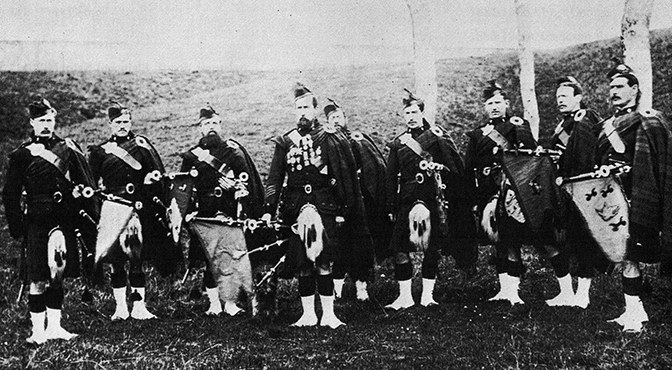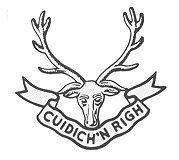
Today we begin abridged excerpts from the above book by Ian Hamilton Mackay Scobie. The book was published in 1924 and is now out of print. It contains interesting details on the origins of titles such as ‘Pipe Major’ and the author also comments on drums drowning out pipes, questions whether playing in a band helps the piper’s playing and gives a date for the formation of the first pipe bands. Above is a picture of Seaforth militia pipers in 1880 under P/M Ronald MacKenzie…. 
‘My Loss, My Loss, without Three Hands
Two for the Pipe and One for the Sword’
– Clan MacDougall’s Incitement to Battle (about 1299)
Pipe music has always been fostered and kept up in the 1st Battalion Seaforth Highlanders and the regiment has produced many excellent pipers during its existence. On the raising of the regiment in 1778, each company, and there were ten companies in those days, had its own piper provided and maintained by the captain. In time however, a Pipe Fund was raised and contributed to annually by the officers.
The Earl of Seaforth’s piper was the ‘head piper’ or Piper Major as that position was then called, afterwards changed to Pipe Major and later on officially to Sergeant Piper [in 1822].
In 1920 Sir Bruce Seton wrote in his ‘Pipes of War’: ‘Throughout the Army there is, and always has been, a strong objection to the title of Sergeant Piper which in official parlance is employed instead of Pipe Major. No one ever calls a Pipe Major a Sergeant Piper…and the withdrawal of this modern and indefensible title could result in nothing but good. As there is no financial aspect involved in the change, it would be a graceful and inexpensive concession to a body of men to whom the Army and the nation owe much.’
Pipers, as we shall see later, were not officially recognised in the Army until the year 1854, but they were always kept up and played an important part in the life of all Highland corps, being held in the greatest esteem by officers and men.
The bagpipe has been employed in Scotland and more especially in the Highlands ‘for the purposes of war, to heighten mirth and lighten labour, for marriages, to dance to, as well as to bewail the loss of the brave and the honourable and that, perhaps, from remote antiquity.’ In old times the clan pipers were men of high musical attainments. The courses of training which they underwent, lasting most cases over several years at such piping schools as those of the MacCrimmons and MacArthurs, turned out finished performers.
[wds id=”2″]
A good piper was not easily made and this was fully recognised, for, as the old Gaelic word has it, ‘to the make of a piper go seven years of his own learning, and seven generations before’. After the drastic changes which took place in the Highlands following upon the rising of 1745, the bagpipe fell upon evil days, and, indeed, might even have become extinct but for its continued use in the Highland regiments raised soon after that date.
After a period of depression lasting from about 1747 to 1781, during which time much of the old music was lost, the bagpipe gradually came into its own again and, at the present day is more of a national instrument than ever, while its cult has spread over the world wherever Scotsmen are to be found. In the late world war [WW1] the pipes played an even greater part than they had in past campaigns.
Up to 1854 the position of Pipe Major was a purely honorary one, the holder of it being a Sergeant or a Lance Sergeant, the other pipers being under him for the purposes of music only, while for discipline they were under the Drum Major. The post was paid out of regimental funds, while in order to get the pipers extra pay they were sometimes appointed drummers. The Pipe Major always belonged to the Colonel’s company….
The duties of the day, as is still the case, were marked by the sound of the pipes from ‘sunrise’ to ‘tap-to’. At mess, a piper played to the officers before and during dinner, the regiment assembled to the strains of the pipe, and a piper accompanied all fatigue and market parties to and from the barracks.
The pipes were always used in the Highlands as an aid to labour. When engaged in works of strength and joint tasks such as launching a large boat and the like, the Highlanders commonly employed a piper to regulate the time. Similarly, when thickening the new-proven plaiding or working at the harvest, they did so to the sound of the pipe. In the harvest field the piper generally kept behind the slowest worker. When the inhabitants of Skye were occupied in making roads in the year 1786 each party had a piper.
The drums and fifes and pipes played separately. When fifes were eventually abolished [in Highland regiments], the drum came to be used as an accompaniment to the pipe. Hitherto the pipers had usually played individually when in barracks or in camp. When on the march they had taken post at the head or on the flanks of their company. Only on special occasions did they play together in concert. With the introduction of the drum however the pipe band as we now know it, came into being.
Whether this was to the betterment of the individual piper as a player or not is open to question. To march to, pipes and drums cannot be excelled, the tendency however, being often to drown the pipe with too much drum.
• To be continued.
[wds id=”3″]
















Recent Comments